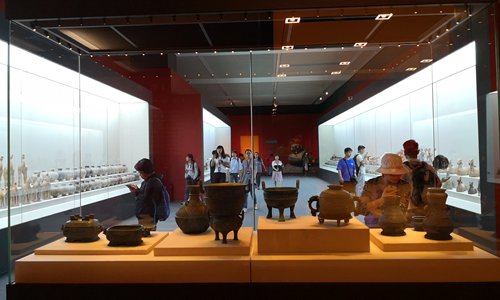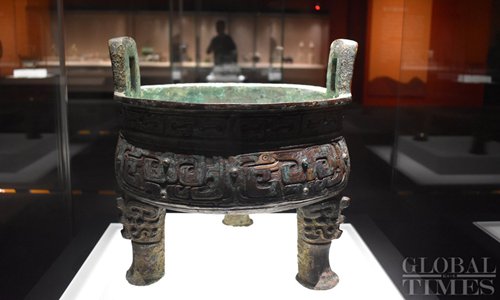HOME >> CHINA
Top museum exhibits 600 retrieved relics
By Chen Xi and Leng Shumei Source:Global Times Published: 2019/9/19 22:08:40 Last Updated: 2019/9/20 14:52:23
Exhibit shows national efforts, enthusiasm to protect heritage: expert

Tourists visit the exhibit of recovered Chinese cultural relics from overseas at the National Museum of China on Tuesday. Photo: Courtesy of museum visitor Feng Shengyi
Visitors flooded to the National Museum of China, as 600 long-lost Chinese relics returned to China, including bronze animal heads looted from the Old Summer Palace, are on exhibit together for the first time to celebrate the 70th anniversary of the founding of the People's Republic of China.
Many web users also expressed eagerness to visit the exhibit during the National Day holidays, saying they were excited to see the long-lost relics. The most popular relics are the 12 bronze animal heads representing the Chinese zodiac.
"Welcome home!" users of China's Twitter-like Sina Weibo social media platform said. The hashtag "12 bronze animal heads reunite at the National Museum of China" had been viewed nearly 100 million times as of press time.
The animal head sculptures were part of a water clock at Yuanmingyuan, or the Old Summer Palace, in Beijing. They were looted by Anglo-French forces during the Second Opium War in 1860.
Six original sculptures and six replicas were on show at the exhibit, which lasts from Tuesday to the end of November.
Over 600 cultural relics from 13 provinces and cities and 18 museum and cultural institutions nationwide are on display, the National Cultural Heritage Administration said in a statement sent to the Global Times on Tuesday.
This is the first time China has carried out a panoramic display of the country's history of lost cultural relics retrieved since 1949, including Chinese pottery, bronze ware, paintings and calligraphy, the statement said.
Feng Shengyi, who majored in intangible cultural relics studies at Beijing City University, has visited the exhibit twice since it opened on Tuesday.
His favorite works are the Five Oxen painting by Han Huang from the Tang Dynasty (618-907) and the Chinese calligraphy model Letter to Bo yuan (Boyuan tie) by Wang Xun from the Eastern Jin Dynasty (317-420).
They were displayed four years ago at an exhibit in Beijing to celebrate the 90th anniversary of the Palace Museum. Feng said he hopes to gain new insight from them.
"The exhibit provides a great opportunity as it includes many rarely seen relics," Feng said. It must be a tough and challenging process to retrieve the relics, like the stolen Longmen Grottoes Buddha statues and stone relief carvings looted from the tomb of Wang Chuzhi (863-923), a senior military governor in ancient China, he said.
The return of more long-lost relics demonstrates China's development, patriotic people's contribution and Chinese people's enthusiasm to protect relics and culture, he stressed.

Photo: Chen Xi/GT
"This exhibit tells the history of the country's development through a unique perspective of lost cultural relics, and vigorously carries forward the spirit of patriotism," said Liu Yuzhu, director of the National Cultural Heritage Administration, at the exhibit's opening ceremony on Tuesday.
Guan Qiang, deputy director of the administration, told the Global Times at the ceremony that 150,000 pieces of lost Chinese cultural relics had been retrieved since 1949.
"The methods include diplomatic negotiations, law enforcement cooperation, judicial proceedings, negotiated donations, rescue work and commercial purchases. Each retrieval is difficult due to its complexity and historical issues, so we need to combine different ways to retrieve the relics," Guan said.
Chinese and international laws have played an important role in the retrievals, Huo Zhengxin, a law professor at the China University of Political Science and Law, told the Global Times.
China has built a database of stolen cultural relics and is planning to expand it, Guan said, noting that they would digitize cultural relics, especially fragile ones, and let more people around the world discover the charm of Chinese culture.
The Chinese government has signed bilateral agreements with more than 20 countries, including the US, Italy and Switzerland, on the recovery of cultural relics and the establishment of cooperation mechanisms under the framework of international conventions.
Posted in: SOCIETY